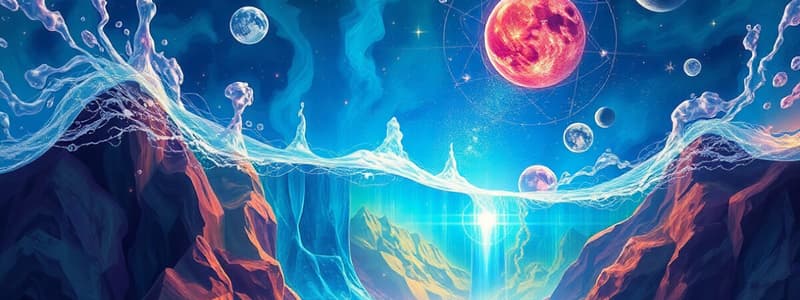Podcast
Questions and Answers
Which state of matter is characterized by having a fixed volume but taking the shape of its container?
Which state of matter is characterized by having a fixed volume but taking the shape of its container?
- Gas
- Liquid (correct)
- Plasma
- Solid
In which state of matter are the intermolecular forces the strongest?
In which state of matter are the intermolecular forces the strongest?
- Gas
- Plasma
- Liquid
- Solid (correct)
Which of the following statements accurately describes the compressibility of gases?
Which of the following statements accurately describes the compressibility of gases?
- The compressibility of gases is similar to that of liquids.
- Gases have a fixed volume and cannot be compressed.
- Gases are easily compressed due to the large spaces between particles. (correct)
- Gases are nearly incompressible due to strong intermolecular forces.
What phase change is occurring when water vapor in the air forms dew on the grass?
What phase change is occurring when water vapor in the air forms dew on the grass?
Which process involves a substance changing directly from a solid to a gas without passing through the liquid phase?
Which process involves a substance changing directly from a solid to a gas without passing through the liquid phase?
What must occur for a substance to change from a liquid state to a gaseous state?
What must occur for a substance to change from a liquid state to a gaseous state?
Which of the following is an example of a physical change?
Which of the following is an example of a physical change?
What indicates that a chemical change has occurred?
What indicates that a chemical change has occurred?
Which process describes the conversion of water vapor directly into ice without passing through the liquid phase?
Which process describes the conversion of water vapor directly into ice without passing through the liquid phase?
In the water cycle, what process is represented by water moving from bodies of water into the atmosphere?
In the water cycle, what process is represented by water moving from bodies of water into the atmosphere?
Which of the following demonstrates the transformation of water vapor into cloud formation in the water cycle?
Which of the following demonstrates the transformation of water vapor into cloud formation in the water cycle?
What happens to the particles of matter when the temperature increases?
What happens to the particles of matter when the temperature increases?
Which statement from the particle theory of matter explains why gases are compressible?
Which statement from the particle theory of matter explains why gases are compressible?
If a solid block of dry ice (solid carbon dioxide) is left at room temperature, it turns directly into gaseous carbon dioxide. What is this process called?
If a solid block of dry ice (solid carbon dioxide) is left at room temperature, it turns directly into gaseous carbon dioxide. What is this process called?
Which change in conditions would most likely cause water vapor to turn into liquid water?
Which change in conditions would most likely cause water vapor to turn into liquid water?
In the context of the water cycle, what term describes water flowing over the land surface and eventually entering bodies of water?
In the context of the water cycle, what term describes water flowing over the land surface and eventually entering bodies of water?
Which of the following is an example of a chemical change rather than a physical change?
Which of the following is an example of a chemical change rather than a physical change?
What property of matter is demonstrated by the fact that a solid object maintains its shape and volume regardless of its container?
What property of matter is demonstrated by the fact that a solid object maintains its shape and volume regardless of its container?
Which of the following statements best describes the behavior of particles in a liquid?
Which of the following statements best describes the behavior of particles in a liquid?
According to the water cycle, what is the direct result of water vapor cooling in the atmosphere?
According to the water cycle, what is the direct result of water vapor cooling in the atmosphere?
Flashcards
Solid
Solid
Solid state with closely packed molecules, strong attraction, fixed shape and volume, and is incompressible.
Liquid
Liquid
Liquid state with molecules that slide past each other, moderate attraction, fixed volume but takes container shape and slightly compressible.
Gas
Gas
Gaseous state with molecules far apart, weak attraction, indefinite shape and volume and is easily compressible.
Melting
Melting
Signup and view all the flashcards
Freezing
Freezing
Signup and view all the flashcards
Evaporation
Evaporation
Signup and view all the flashcards
Condensation
Condensation
Signup and view all the flashcards
Sublimation
Sublimation
Signup and view all the flashcards
Deposition
Deposition
Signup and view all the flashcards
Physical change
Physical change
Signup and view all the flashcards
Chemical change
Chemical change
Signup and view all the flashcards
Change in phase of matter
Change in phase of matter
Signup and view all the flashcards
Evidence of chemical change
Evidence of chemical change
Signup and view all the flashcards
Law of conservation of mass in the water cycle.
Law of conservation of mass in the water cycle.
Signup and view all the flashcards
Evaporation in water cycle
Evaporation in water cycle
Signup and view all the flashcards
Condensation in water cycle
Condensation in water cycle
Signup and view all the flashcards
Precipitation
Precipitation
Signup and view all the flashcards
Particle Theory of Matter
Particle Theory of Matter
Signup and view all the flashcards
Attraction between particles
Attraction between particles
Signup and view all the flashcards
Spaces between particles
Spaces between particles
Signup and view all the flashcards
Study Notes
States of Matter
- Solids have a definite shape and volume because their molecules are closely packed.
- Strong forces of attraction exist between molecules in solids.
- Solids cannot be easily compressed.
- Liquids take the shape of their container but have a fixed volume.
- Molecules in liquids have enough space to slide past one another.
- Moderate or intermediate forces of attraction are present in liquids.
- Liquids can be slightly compressed.
- Gases take the shape of their container and have a varying volume.
- Gas molecules are far away from each other and move freely.
- The force of attraction in gases is weak or negligible.
- Gases can be easily compressed.
Phase Change
- Melting is when a solid turns in to a liquid through heat absorption.
- Evaporation is when a liquid turns into a gas through heat absorption.
- Sublimation is when a solid turns into a gas through heat absorption.
- Solidification/freezing is when a liquid turns into a solid through heat release.
- Condensation is when a gas turns into a liquid through heat release.
- Deposition is when a gas turns into a solid through heat release.
Temperature and Phase Change
- Increasing temperature triggers changes from solid to liquid to gas.
- Melting, evaporation, and sublimation require an increase in temperature.
- Decreasing temperature triggers changes from gas to liquid to solid.
- Freezing, condensation, and deposition all require a decrease in temperature.
Changes in Matter
- Physical change occurs when a substance changes form without changing its chemical identity.
- A physical change still results in the same substance.
- Physical changes affect physical properties and are generally easy to reverse.
- Examples of physical changes include melting of ice, boiling of water, cutting or folding paper.
- Chemical change is accompanied by a change in the chemical identity of a substance.
- A chemical change forms a new substance and affects both physical and chemical properties.
- Chemical changes are not easy to reverse without additional chemical reactions.
- Examples of chemical changes include the formation of bubbles when food is spoiled, formation of rust, and lighting a matchstick.
Evidences of Physical Change
- Change in phase of matter
- Change in size
- Change in mass
- Change in shape
Evidences of Chemical Change
- Change in color, odor, taste
- Change in chemical composition
- Formation of new substance
- Formation of gas (bubbles)
- Formation of heat and light
Water Cycle
- The water cycle demonstrates how water is conserved on Earth through phase changes.
- Evaporation is when water turns into water vapor from bodies of water.
- Condensation is the formation of clouds from water vapor.
- Precipitation is the process of "raining" or water falling back to earth.
- Water runs off from mountains into bodies of water.
Particle Theory of Matter
- Matter is composed of tiny particles.
- The particles have spaces between them.
- Particles are constantly in motion.
- The particles of matter attract each other.
Studying That Suits You
Use AI to generate personalized quizzes and flashcards to suit your learning preferences.




